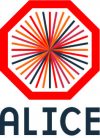 ALICE is one of four giant experiments at the Large Hadron Collider (LHC).
ALICE is one of four giant experiments at the Large Hadron Collider (LHC).
The ALICE (A Large Ion Collider Experiment) detector weighs nearly 10,000 tonnes, more than the Eiffel Tower; it is 16 m high and 26 m long. More than 1900 physicists and engineers from 39 countries are working in international collaboration on the experiment.
ALICE has more than 25 years of history, and Hungary has been represented in the cooperation from the very beginning. The aim of the experiment is to produce and study the early state of the Universe, the hot, dense “quark-gluon plasma” that existed in the first millionth of a second after the Big Bang. To create a quark-gluon plasma, lead nuclei accelerated to near the speed of light are collided at the centre of the detector at an energy of 5.5 TeV (i.e. 5,500,000,000,000,000 eV). The Hungarian ALICE Group aims to study the physics of this highly interacting matter with extreme energy density.
| Short name | CERN LHC ALICE kísérlet |
| Name | A Large Ion Collider Experiment |
| Official website | CERN ALICE: http://aliceinfo.cern.ch Hungarian ALICE Group: http://alice.wigner.mta.hu |
| foundation | 1993 |
| ESFRI project/landmark | landmark |
| Headquarters | Geneva, Switzerland |
| Number of member countries | 39 |
| Participating countries | Armenia, Austria, Azerbaijan, Bangladesh, Brazil, Bulgaria, China, Croatia, Cuba, Czech Republic, Denmark, Finland, France, Germany, Greece, Hungary, India, Indonesia, Italy, Japan, Korea, Malta, Mexico, Netherlands, Norway, Pakistan, Peru, Poland, Romania, Russia, Slovakia, South Africa, South Korea, Sweden, Switzerland, Thailand, Turkey, Ukraine, UK, USA |
| Hungary’s accession | 1996 and 2005 |
| Partner institutions in Hungary |
Wigner Research Centre for Physics (FK) Institute for Nuclear Research (ATOMKI), Eötvös Loránd University (ELTE), Cerntech Kft. |
| Professional representative | Gergely Gábor Barnaföldi, group leader Wigner Research Centre for Physics |
| Membership payments | 2016: CHF 54,337 (≈ HUF 15.6 million) 2017: CHF 54,703 (≈ HUF 15.8 million) 2018: CHF 53,640 (≈ HUF15.8 million) 2019: CHF 46,513 (≈ HUF 15.3 million) 2020: CHF 46,319 (≈ HUF 15.3 million) |
Summary of professional cooperation/programme
- The ALICE experiment brings together 1906 researchers from 175 research institutions in 39 countries in close international scientific collaboration.
- To date, 59 Hungarian researchers and engineers have been involved in the research project, of which 27 are currently active.
-
Activities of the Hungarian ALICE Group at the Wigner Research Centre for Physics:
Basic research projects:- Experimental study of quark-gluon plasma formation: description and theoretical modelling of processes in high-energy nucleus-nucleus collisions, analysis of particle jets, study of nuclear effects in ultra-relativistic high-energy nucleus-nucleus collisions.
- Correlation and jet structure studies: correlation measurements of inclusive and identified hadrons using the TPC and ITS detectors of the ALICE experiment. A multiplicity-dependent study of the structure of jets in small systems.
- Investigation of heavy quark production in the ALICE experiment.
- Study of high-energy nuclear effects: theoretical modelling of processes in high-energy proton-proton and proton-nucleus collisions, separation of soft and hard processes.
- High-pulse, identified light and heavy hadrons, data analysis with the HMPID sub-detector and the time projection chamber (TPC).
- Heavy-ion physics modelling: development of the HIJING++ Monte Carlo simulation code in the ALICE AliROOT framework
- ALICE TPC detector R&D: development of the ALICE Time Projection Chamber (TPC) with GEM technology, currently in the GEM lab in collaboration with REGARD and the Innovative Gas Detectors Momentum Group, development and construction of GEM and multi-fibre gas-filled detectors (2016-2021).
- The LHC Interface (LHC_IF) project will ensure the flow of data between the Large Hadron Collider (LHC) and ALICE, and thus the safe operation of the experiment (2016-2022).
- Investigation of the CsI photocathode efficiency of the HMPID detector: based on continuously recorded data. (2008–2022).
- R&D of the VHMPID detector: identification of very high pulse particles (2005-2014).
- Data acquisition, compression and transmission (DAQ) system of the ALICE detector: from 2008 onwards, data from the ALICE detector were collected by the data acquisition system jointly developed by MTA KFKI RMKI and CERN and manufactured by Cerntech Kft. (2008-2019); the present development is a new data transmission system with 4 TBps bandwidth for the 2nd Long Shutdown (LS2) period for data collections after 2020.
- ALICE WLCG LHC GRID: data analysis, program development, operation of the CERN Tier-2 centre (1300 CPUs, 850 TB, 2009-2021).
- ALICE Analysis Facility (Wigner_AF) R&D: Research and development of a specialised hybrid (GPU and FPGA based) analysis system with high data density and data intensive computing capacity, in collaboration with the Wigner GPU Laboratory and the Wigner Data Centre (2021-)
Benefits of the membership for Hungary
- Share in the scientific results of the experiment, outstanding scientific publication performance.
- Access to high energy collision data and complex data analysis software that can only be provided by the LHC infrastructure.
- Participation in detector development programmes, international scientific networks and projects.
- Use of the Worldwide LHC Computing Grid, a global computing infrastructure.
- Opportunity for Hungarian SMEs to join high-tech projects.
- Technology transfer: the use of innovations in applied research.
- Opportunities to participate in CERN student programmes and scholarship schemes.
- Participation in CERN’s ALICE science popularisation programme.
- Domestic science popularisation: http://alice.wigner.hu/sajtoszemle
- Opportunity for PhD, MSc, BSc students to gain competitive scientific and technological research and development experience in an international environment, at globally leading research institutions.
- Awarded funding: K135515 (2020-2024), FK131979 (2019-2023), 2019-2.1.11-TÉT-2019-00050 (2020-2023), 2019-2.1.11-TÉT-2019 -00078 (2020-2023), 2019-2.1.6-NEMZ_KI-2019-00011 (2020-2023), K120660 (2016-2020), NK106119 (2012-2016), NK 77816 (2009-2013), CK 77815 (2009-2013), H07-C 70464 (2007-2010), IN 71374 (2007-2008), NK 62044 (2006-2009).
About ALICE in a nutshell






